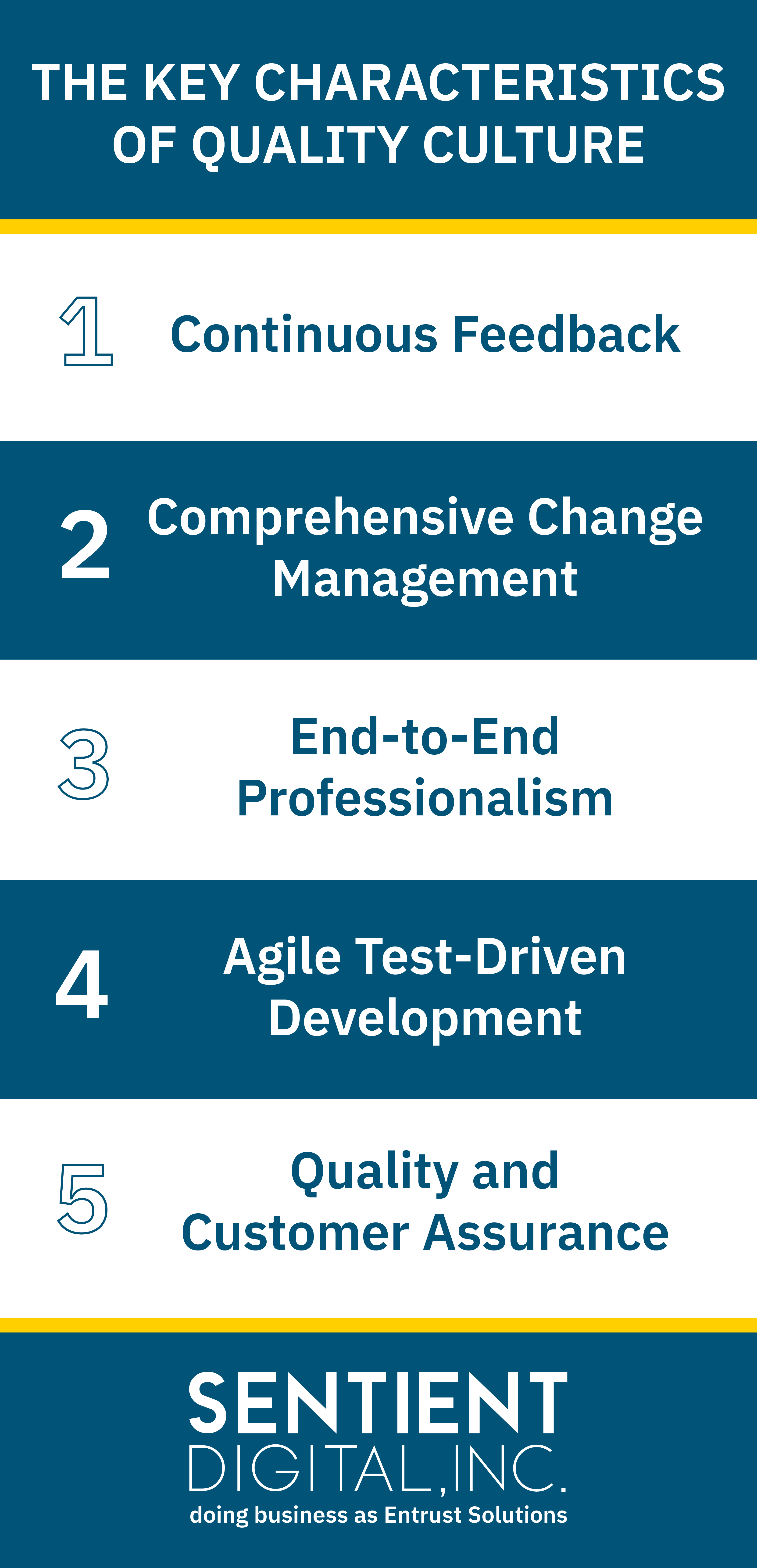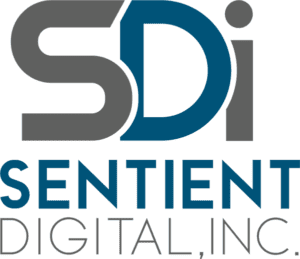What are the characteristics of quality culture and how can you foster one in your organization? Having a quality culture demonstrates an organization-wide commitment to providing excellent products or services, and continuous improvement. This culture is impossible without all employees sharing a belief in the importance of the work and taking ownership for the quality of the results they deliver. With a strong culture of quality as a foundation, an organization sets itself apart from its competitors and can grow organically based on the value of its products or services. Establishing a quality culture cannot happen overnight, and will require a concerted effort at all levels of the organization. While the initial effort may come from leadership and HR, employees will have to understand the importance of the initiative and commit their efforts to it. Over time it will become second nature, the typical way of operating that earns customer loyalty and separates your organization from others in your industry.
In the workplace, cultures of quality are far more complex than promising assurances, warranties, and customer service helplines. Truly effective and compelling characteristics of quality culture include:
- Continuous feedback
- Comprehensive change management
- End-to-end professionalism
- Agile test-driven development
- Quality and customer assurance
Keep reading to learn more about how cultures of quality are created, enriched, and maintained for the benefit of both the companies themselves and the clients they serve. We’ll share our own experiences developing a culture of quality at Sentient Digital, doing business as Sentient Digital, Inc., including the benefits of ISO 9001 certification to assist with quality improvement. More recently, we have obtained ISO 27001 certification, indicating the ongoing commitment that a lasting quality culture requires.
THE IMPORTANCE OF QUALITY CULTURE
In an increasingly saturated and globalized market, competitive pipelines have forced businesses across industries into cutting corners with compressed cycle times and flimsy deliverables. According to the Harvard Business Review, “just as companies’ margin for error has decreased, the likelihood of error has risen.”
The cultural narratives concerning defects, recalls, and corporate apologies are growing threadbare as consumers become progressively disillusioned. Now, more than ever, companies must turn to holistic, end-to-end quality transformations rather than one-off patches and mitigation campaigns that solve problems retroactively.
“Quality” is often deployed as an adjective to promote specific goods and services. But quality can—and should—extend far beyond isolated use cases. Companies should actively strive to transform quality into a cultural touchstone shared between managers, employees, and clients.
For technology solutions providers, quality is more than an aspiration; it’s a responsibility. An organization’s systems are critical to its operations, so the people who work on them need to be committed to the quality of their work. Leveraging best practices in software development, systems engineering, data management, and user experience design enables us to deliver the results that our clients deserve. The only way to do this is through a solid commitment to quality and continuous improvement.
Why Quality Culture is Particularly Important for Technology Companies
Creating a culture of quality is essential for a technology solutions provider because quality directly impacts the trust that your customers have in you and their ability to rely on your work. Investing in technical infrastructure, hardware, software, services, and ongoing support, business decision makers need to have confidence that the effort and resources will be well worth it.
When providing technology services to government and military clients, the stakes can be even higher. Quality service is imperative, for everything from facilitating efficient operations to ensuring national security.
In order to facilitate this, organizations should embed quality assurance testing and quality control processes throughout product development cycles, as well as maintain an ongoing commitment to quality while providing services on the client site as well. By thoroughly vetting and validating technologies before deployment to customers, companies can take a proactive approach to any issues that show up. Quality testing and controls should be present from client onboarding, through solution configuration and integration, data migration, and go-live also ensuring quality throughout the process.
Another important aspect of a culture of quality is instituting consistent processes and quality benchmarks across the company ensures consistency of service even as the business grows or as employees leave and are replaced. This means creating quality standards for things like response times, resolution rates, time to recovery for system issues, and overall uptime statistics, so that quality can be evaluated consistently over time and changing conditions. This will also create reliability for your customers over time and help build your brand reputation.
Your brand’s genuine reputation for quality is very important as you aim to gain customers and clients via word-of-mouth. Earning a reputation for quality will encourage your clients to spread the word about you. Fostering a quality culture will pay off in increased revenue over time.
“As a provider of technology solutions that support our customers’ critical missions, a culture of quality is an essential component in ensuring we consistently meet our customers’ expectations and requirements,” affirms Alison Johnson, our Director of Program and Portfolio Management. “Quality solutions and results are not always found in the defense space, but should be expected. Establishing a culture of quality is a vital element of delivering innovative, differentiated products and services.”
Understanding how to cultivate quality behaviors, mindsets, and practices within in-house teams can help ensure that you build growth and capitalize on latent opportunities in far more sustainable ways.
THE KEY CHARACTERISTICS OF QUALITY CULTURE
A true culture of quality becomes so deeply embedded as to be indiscernible from otherwise day-to-day operations. No single individual can create quality on their own—whole entities, groups, and company departments are responsible for bolstering and maintaining quality standards. The key characteristics of quality culture are as follows.

CONTINUOUS FEEDBACK
“We work to ensure there is a continuous focus on identifying and reporting feedback throughout the company,” says Johnson. “This allows us to increase individual engagement in quality and improvements.”
Giving and receiving feedback empowers employees to bring constructive suggestions to the table, effectively lowering engagement barriers when it comes to project development and improvement. The more diverse voices and insights being lent to a specific initiative, the more likely it is that quality will begin to emerge in that endeavor.
Interpersonal feedback leads to quality as well, and using that feedback to enrich employee talent pools is exceptionally important. Employees need feedback from employees at the same level as them, as well as their team leader and immediate supervisor. Employee feedback surveys can be one way to facilitate this, particularly if they allow for evaluating on pre-set metrics of quality as well as featuring open-ended questions. Finally, asking for feedback from customers can help make it clearer how the quality of employees’ work impacts the customer.
Read about how the SFIA framework bolsters internal faculties that lead to resilience, cultural improvement, and the effective use of interpersonal resources.
COMPREHENSIVE CHANGE MANAGEMENT
Change in the workplace can often feel disjointed and unsettling. Unfortunately, quality is usually one of the first casualties in the race to alleviate compromised efficiency during periods of company upheaval, staff turnover, or software transformation.
Comprehensive change management ensures that both quality and stability go hand in hand. Effective management practices ensure that the details—whether critical or minor—are never sacrificed or lost during the transition process.
One significant key to maintaining quality standards amidst workplace change is communication. Stakeholders at all levels need to understand the reasons, timeline, and benefits of the transition. At the same time, employees should be encouraged to provide feedback and contribute their insights, because culture changes will not stick without employee buy-in. Additionally, training will help employees to implement new ways of doing things while maintaining or enhancing quality.
With proactive planning, strong project management, and consistent messaging, quality does not have to suffer during periods of organizational change. Taking into account the experiences of employees and showing that their feedback matters will help them to get on board with changes while maintaining the quality of their work.
END-TO-END PROFESSIONALISM
Quality facilities end-to-end professionalism. From the very inception of a project up to its delivery deadline, quality should define every rung in the development process. Clearly understanding the client’s needs and tailoring the development of solutions for them will ensure that you can meet client expectations at all stages. Strict version control, peer reviews, and testing ensure quality during active development. After launch, continued monitoring of performance metrics, collecting user feedback, and being available to handle any issues will ensure the quality does not diminish over time.
“As a client-facing company, we strive to demonstrate our culture of quality from the very first interaction with every customer. Being able to clearly communicate a culture of quality is critical in building lasting, productive client relationships,” asserts Johnson.
AGILE TEST-DRIVEN DEVELOPMENT
Inevitably, tight delivery pipelines in competitive markets will often prioritize continual innovation over retroactive quality control for existing offerings. That’s why the theory of maintaining continual evaluative standards has proven absolutely integral to the promotion of cultures of quality.
The concept of test-driven development (TDD) applies to far more than the realm of software production. The principles behind TDD lay the groundwork for a widely applicable strategy that promotes constant assessment, testing, and calibration throughout the development process.
TDD finds the value in “failure” as a starting place for strengthening quality. When accounting for the risks associated with any given project, true agility embraces the process as continuous, improvement-driven, and ever-evolving.
QUALITY AND CUSTOMER ASSURANCE
According to Johnson, “With the criticality of the solutions we are building and integrating for our clients, the tolerance of quality issues is nearly non-existent. Any debate on the quality of a product ultimately comes back to customer satisfaction.”
When test-driven development and other strategies fail to identify lapses in quality during the production process, customer assurance services exist to quickly and efficiently remediate difficulties after they become apparent.
Cultures of quality highlight present problems rather than burying or camouflaging them. Issues may be successfully dealt with only after they are actively acknowledged by customer assurance task forces. However cultures of quality may operate internally, client-facing quality assurance is the ultimate culmination of these ideals and practices.
DEVELOPING INTERNAL AND EXTERNAL CULTURES OF QUALITY

How are the characteristics of quality culture actually put into practice? The following four tactics can help organizations develop a culture of quality.
QUALITY THROUGH DEDICATED LEADERSHIP
Leading by example, company leadership can reinforce holistic quality ideals. Corporate management should always exhibit an end-to-end commitment to maintaining quality in their own professional attitudes and affairs. This increases the chances of collective buy-in among employees and teams.
Moreover, setting material standards for quality management (often in conjunction with other staff members and department leads) will help better overall quality assessment in the workplace. These may include concrete evaluative metrics, surveys, or performance incentives.
PEER-DRIVEN COMMITMENT
While solely material incentives for improvement may provide increased short-term efficiency (thus inflating the effects of these campaigns), contemporary research shows that they ultimately produce stunted long-term results that aren’t representative of sustainable growth.
“A true culture of quality lives in our organization when every person experiences and understands the need for dedication to it. Quality is a constant path to improvement, where every individual is surrounded by, and encourages others to take quality-focused actions,” affirms Johnson. Interpersonal accountability and support are vital quality-building tools. Promoting both accountability and support between team members is a key building block for a culture of quality. Knowing that they will be accountable to their peers will help employees take ownership of their contributions and ensure that they communicate any issues to avoid downstream defects. Collaborating with teammates will also help them to meet quality standards, supporting each other sharing expertise and resources.
In the context of a culture of quality, supervisors should focus on their role as coaches, helping employees to develop the skills they need to reach the standards expected in a culture of quality. However, they can also help by creating an environment in which peers are encouraged to support each other and hold each other accountable.
How to Involve Employees in Culture of Quality Efforts
A culture of quality is composed of the individuals who embody the characteristics of quality culture. To make this possible, organizational leaders need to communicate the reasons why quality matters, such as customer satisfaction, company growth, and job stability. Employees need to connect their day-to-day tasks with the values of a culture of quality.
One of the most important ways to involve employees in your efforts to foster quality is to reward their behavior when they demonstrate a commitment to quality. This does not necessarily need to involve financial compensation; it could be something as simple as telling them that they did a good job, and perhaps noting this for their next performance review. This will continue to reinforce that the organization values quality and encourage employees to participate in these efforts.
It is also important to support employees as they make changes to enhance the quality of their work. This could involve providing additional skills training as well as training in the new standards that will be expected. When employees feel supported, encouraged, and recognized, they may be more likely to embrace a new organizational culture.
ORCHESTRATING CYCLES OF IMPROVEMENT
Drawing from the quality characteristics pertaining to feedback and customer assurance, reference the Japanese concept of “kaizen,” or “a philosophy of continuous improvement [that] provides an approach to engage the people who do the work to quickly identify and implement rapid improvement opportunities.”
Inherent in a culture of quality is a mindset of continual improvement; beyond fixing problems, it involves actively seeking to improve products and processes. This means that employees at all levels should be encouraged to note areas for refinement, both in their own work and in the way the company as a whole operates. It can help to provide avenues for employees and clients to give feedback to ensure a balance of perspectives. You should have a system in place to review the feedback and determine how to address it. This should be an ongoing process of collecting feedback, reviewing it, devising solutions and implementing them. In a culture of quality, everything can always be improved.
Cycles of improvement operate both vertically and horizontally. They move to address problems systematically from the bottom up, while also working toward meeting lateral long-term goals with broader scope.
ENRICHING EMPLOYEE OWNERSHIP
Adopting “cradle-to-grave” approaches to project management enriches an employee’s sense of responsibility to the initiatives placed under their jurisdiction. Employees are able to better cultivate a deep sense of ownership from a project’s ideological conception, to its delivery to the customer.
The concept of ownership is important in a successful culture of quality. When employees feel a true sense of ownership for the work they do, this means that they believe that the quality they deliver matters, and that their performance will be measured according to the success of their projects. This will further motivate them to fully understand client needs and objectives. They have a pride in meeting and exceeding customers’ expectations. This also encourages them to proactively identify issues and suggest areas for improvement. Management can bolster this ownership mentality by empowering staff and ensuring that each employee receives credit for their role in collective success.
Quality ideals should be embedded during employee onboarding and encouraged every day of employment thereafter.
THE BENEFITS OF ISO 9001 CERTIFICATION PROGRAM TO PROMOTE QUALITY CULTURE
Because true cultures of quality are so deeply embedded within company operations and relationships, it can often be difficult to evaluate such systems with precision and specificity. Enhancing an organization’s ability to articulate the ways in which they have achieved exceptional quality in the workplace is among the many benefits of ISO 9001 certification.
ISO 9001 is a part of the ISO 9000 family set forth by the International Organization for Standardization (ISO), a worldwide leader in global innovation and solution-building. According to recent numbers, ISO 9001 certifications have been issued to “over one million companies and organizations in over 170 countries” thus far.

9001 is the only international standard for quality management systems (QMSs) that requires external certification. It’s an entirely scalable and intersectional methodology that publicly signals a company’s intensive working dedication to consistently improve its products and services over a sustained period of time.
Earlier this year, Sentient Digital underwent the thorough evaluation and auditing processes that led to the acquisition of our ISO 9001 certification. We want to show our clients and stakeholders that our commitment to quality and customer satisfaction runs deeper than mere business. It’s a living core tenet of our organization that we are proud to uphold.
Interested organizations should follow these clear-cut guidelines to receive ISO 9001 certification.
Sentient Digital Furthers Its Quality Culture with ISO 27001 Certification
In 2023, Sentient Digital achieved ISO 27001 Certification. The full name of this qualification is ISO/IEC 27001 Certification and it represents a significant achievement that demonstrates commitment to quality in the area of cybersecurity. Attaining this qualification signals an organization’s dedication to high-quality data protection compliance.
With data protection being critically important in the digital era, Sentient Digital sought ISO 27001 certification to showcase our data protection capabilities. This widely trusted information security standard shows that our government, military, and private sector clients can rely on us to utilize best practices in safeguarding their data. In a constantly evolving threat landscape, ISO 27001 certification illustrates our commitment to providing our clients with the highest quality protective measures for their sensitive data.
SENTIENT DIGITAL’S QUALITY SOLUTIONS
As the technology solutions industry continues to expedite its products to keep up with an ever-evolving digital infrastructure, it’s increasingly important to uplift the standards of quality that may otherwise be sacrificed along the road to addressing critical IT problems. Now, more than ever, entrenched cultures of quality are necessary to uphold longevity and client trust within our industry. Our culture of quality runs through everything that we do. We take a proactive, metrics-driven approach that turns our passion for our work into measurable results.
With the many benefits of ISO 9001 certification to reinforce our innate dedication to providing top-notch services, Sentient Digital, is proud to uphold the characteristics of quality culture in all of our endeavors and departments. We provide quality technology services for defense, federal, and commercial clients.
Contact us today to learn more about how we can help your organization thrive. Or if you’re a technology professional looking to join a company culture of quality, read about starting a career at Sentient Digital.




